AI Copilot guide: what are they and how do they help enterprises
.jpg)
Here’s how AI copilots are helping make better decisions and unlock enterprise efficiency.
AI adoption is surging, but enterprise readiness is lagging. According to Kore.ai’s Practical AI Insights report, 71% of companies are actively using AI across departments, yet only 30% say they’re fully prepared to scale it. This suggests that while the appetite for AI is strong, the necessary foundations to support it, including data, infrastructure, governance, and talent, are still catching up.
This disconnect plays out daily across the enterprise. Teams are surrounded by intelligent tools, yet still bogged down by siloed systems and decision-making bottlenecks.
AI Copilots are designed to close the execution gap. They don’t just add automation; they embed intelligence into the daily workflows. These intelligent Copilots streamline operations, aid decision-making, provide actionable insights, and help organizations stay agile and competitive.
So, how exactly do AI Copilots make a difference in practice? And as they mature into autonomous Agentic AI systems, let’s take a closer look at how they’re reshaping enterprises and driving real transformation.
Key takeaways (The TL;DR):
Before you dive into the specifics, here’s what you need to know:
- Chatbots AI ≠ AI Copilot ≠ AI agents. Chatbots handle FAQs. Copilots assist with tasks. Agents act autonomously.
- Copilots work best when trained on your enterprise context. You need copilots fine-tuned on your data, processes, and terminology; otherwise, they’ll sound smart but act clueless.
- Governance and trust are critical. You need copilots that are auditable and explainable. If you can’t trace how it made a decision, you can’t trust it in regulated environments.
What is an AI Copilot?
AI Copilot is a context-aware, always-on intelligent companion that helps you work efficiently. Unlike chatbots that answer basic questions, AI Copilots support you in complex decision-making by providing real-time insights and automating multi-step tasks. They understand your goals and guide you through tasks with precision.
At their core, AI Copilots combine the power of large language models (LLMs), natural language processing (NLP), and real-time data access to deliver meaningful support across roles and industries. Whether you’re drafting a report, resolving an IT ticket, onboarding a new hire, or analysing customer feedback, copilots help you do it faster and with less friction.
Here’s what sets them apart:
1. Context-aware intelligence
Copilots don’t operate in isolation. They’re built into the tools you already use, such as email platforms, CRMs, spreadsheets, and service desks. That means smarter suggestions and more relevant outcomes.
2. Natural, conversational interface
You don’t need to learn commands or click through menus. Just ask. Copilots interpret plain language and respond with clarity, whether it’s “summarize this report,” “draft a follow-up email,” or “analyze this data set.”
3. Generative capabilities
From writing code to creating presentations, Copilots are powered by generative AI and can generate content on demand.
4. Workflow integration
Copilots are designed to work within your existing systems, not outside them. That means they can automate routine tasks, surface insights, and even trigger actions across platforms, all without disrupting your flow.
5. Role-specific utility
The definition of a copilot shifts depending on where it’s deployed. In IT, it might resolve tickets and diagnose issues. In HR, it could streamline onboarding and answer policy questions. In sales, it might prep meeting briefs and suggest next steps.
How does AI Copilots work?
Before we dive into the mechanics, let’s pause for a moment. Think about your day: how much time do you spend digging through spreadsheets, chasing down data, or toggling between apps just to get a clear answer?
Now imagine having a digital ally that not only understands what you need, but acts on it, instantly.
Why should this matter to you?
- Imagine having a tool that’s always learning from your choices and the results they produce.
- Think about being able to access real-time data trends tailored to your industry, business needs, and goals.
- Picture making proactive, informed decisions instead of reacting to challenges when they hit.
Here’s how Copilots typically works under the hood:
Ingesting and organizing data
AI Copilots start by absorbing vast amounts of information, documents, emails, CRM entries, support tickets, and more. This data is structured and indexed to form a unified knowledge base. Think of it as giving your Copilot a panoramic view of your business, from the boardroom to the back office.
Understanding user intent
Using advanced NLP, the Copilot interprets your request, not just the words, but the intent behind them. Whether you ask, “What’s our Q3 pipeline looking like?” or “Can you draft a follow-up email for this lead?”, it understands context and urgency.
Generating contextual responses
Once it grasps your intent, the Copilot taps into LLMs and enterprise-specific data to craft a response. It doesn’t just pull generic answers; it references prior interactions, current business data, and relevant documents to deliver tailored, actionable insights.
Automating tasks
Here’s where agentic AI comes into play. Modern Copilots don’t just suggest, they do. From resetting passwords to generating reports, scheduling meetings, or even initiating workflows across systems, they act autonomously—no need to jump between apps or chase approvals. The Copilot handles it.
Learning and improving
Every interaction teaches the Copilot something new. Machine learning algorithms continuously refine their understanding, helping them respond faster, more accurately, and more strategically over time.
What are the key business benefits of AI Copilot?
AI Copilots are rapidly becoming indispensable allies in the modern enterprise. Let’s now explore the core business benefits of deploying AI Copilots, from unlocking better decision-making and boosting operational efficiency to gaining the competitive edge.
1. Unlock better decision-making
No matter how experienced you are, decision-making isn’t always straightforward. Today’s challenges require leaders to be nimble and data-driven.
But how do you ensure you’re making the right decisions, fast? This is where an AI Copilot comes in. It processes data at lightning speed, unearths hidden insights, and presents options you might not have considered.
Here’s how AI Copilot transforms decision-making:
- Advanced analytics at your fingertips: The sheer volume of data available today is mind-boggling. But with AI, it’s not about getting more data; it’s about getting the right data. AI Copilots analyze key business metrics, trends, and even customer sentiment to provide you with the most relevant, impactful information. The goal? To help you make informed decisions faster.
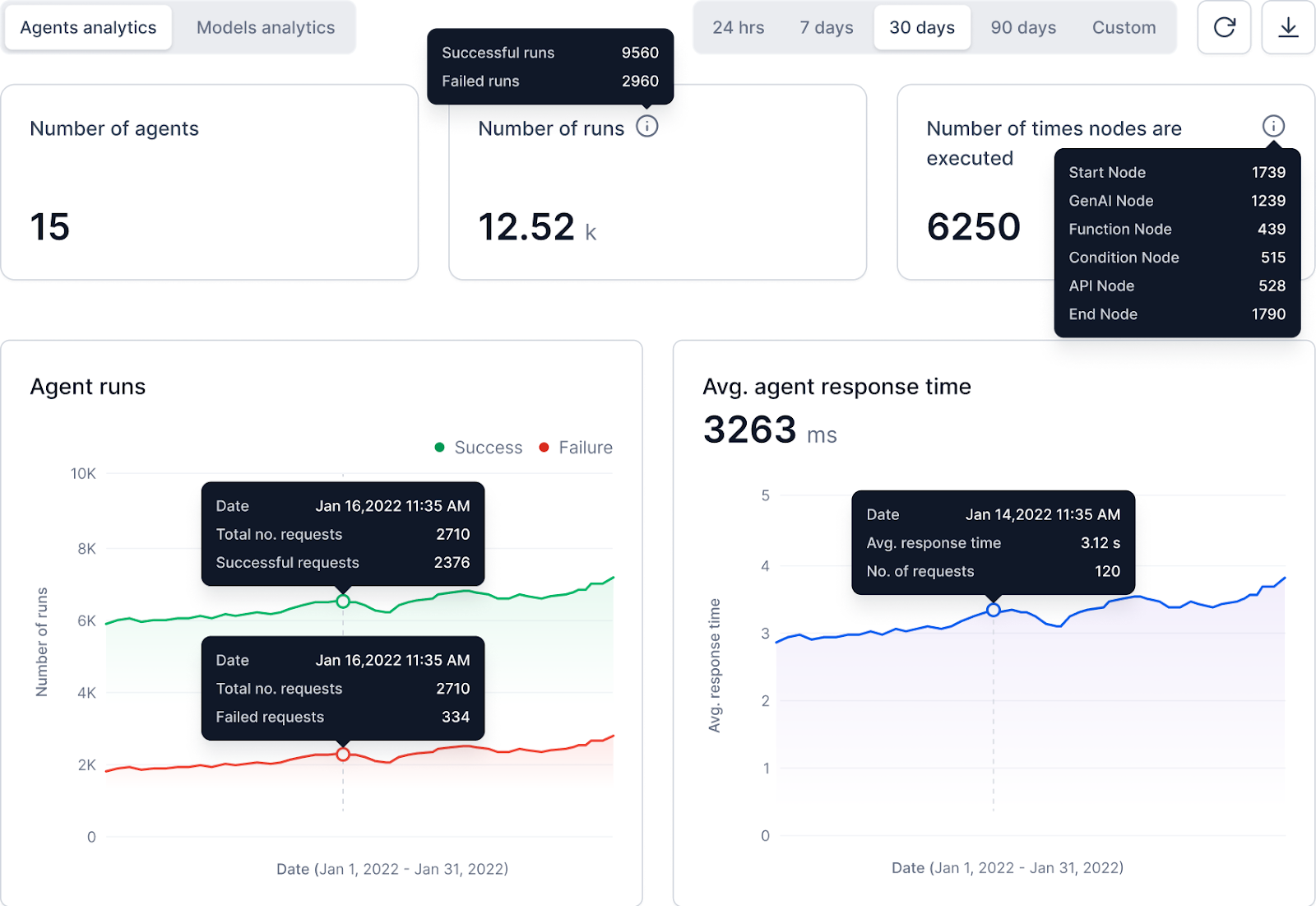
Kore.ai AI for Process - Visibility of AI Agent & Model Performance
- Predictive insights for proactive leadership: Imagine if you could anticipate market shifts, consumer behavior changes, or potential risks before they happen. AI Copilots offer predictive capabilities that allow you to stay ahead of the curve. Think of them as a GPS for your business decisions.
- Less guesswork, more results: If you’re like most leaders, you’ve probably relied on intuition to guide some decisions. While experience is important, AI Copilots remove a lot of the guesswork by giving you data-driven recommendations and ensuring your decisions are backed by solid facts.
2. Boost operational efficiency
As leaders, you're constantly faced with the challenge of balancing day-to-day operational tasks with high-level strategic goals. While “work smarter, not harder” is a popular mantra, how often do we truly put it into practice? With AI Copilots, this is no longer just an ideal; it becomes a reality. These digital partners handle the routine, freeing up your team to focus on what drives growth.
Here’s how AI Copilots transforms your operations:
- Automating repetitive tasks: Think about the daily administrative tasks that often consume your team’s time, scheduling meetings, answering routine customer queries, and managing emails. AI Copilots take care of these tasks quickly and accurately, ensuring your team spends less time on administrative work and more on mission-critical activities.
- Speeding up processes: Whether it’s onboarding new hires or generating reports, AI Copilots streamline workflows, reducing the time needed to complete tasks while increasing accuracy. This automation cuts down on human error and allows your team to focus on strategic work without worrying about the details.
- Optimizing resource allocation: AI Copilots don’t just automate, they analyze. They learn from your team’s workflows and identify areas where resources may be over- or under-utilized. This allows them to provide real-time recommendations for better allocation, ensuring maximum productivity without compromising quality.
By offloading time-consuming tasks to AI Copilots, your team can focus on high-value work, improving overall productivity and efficiency.
The result?
A more agile, high-performing team that drives results and keeps your business moving forward.
3. Drive innovation with AI
Innovation is at the heart of every successful business strategy. But the problem is, how do you keep innovating when your resources are spread thin and you’re constantly battling against market pressures? The solution lies in leveraging AI to help identify opportunities that might otherwise be missed.
Here’s how AI Copilots can help in your business:
- Identifying emerging trends: AI excels at processing large amounts of data quickly, spotting patterns and trends that may take human analysts weeks or even months to notice. Whether it’s a shift in customer preferences, technological advances, or market movements, AI can help you act fast.
- Customer-driven innovation: AI Copilots dive deep into your customers’ behaviors and feedback to uncover unmet needs. They can recommend new products, services, or features that align with these evolving demands, keeping you ahead of the competition.
- Product and service optimization: By continuously analyzing your existing offerings, AI can suggest enhancements or refinements that resonate with your audience. It can even identify areas where your competitors are outpacing you, ensuring that you’re always adapting.
Think about it: by using an AI Copilot, you could continuously innovate, responding to shifts in the market as they happen. What new ideas could your business bring to life with AI driving the innovation process?
4. Gain the competitive edge
One of the biggest advantages of AI Copilots is their ability to leverage real-time data, helping you make timely decisions that keep your business ahead of the competition. In today’s world, speed is everything, and having access to the latest data in an actionable format can be a massive advantage.
Here’s why real-time data is critical for your success:
- Instant insights that shape strategy: AI Copilots continuously monitor data from a wide variety of sources, internal systems, social media, financial reports, customer feedback, and more. This means you get real-time updates on performance, customer sentiment, and market conditions.
- Predictive analytics for future success: By analyzing patterns in historical data, AI Copilots don’t just tell you what’s happening; they predict what will happen. With AI’s predictive capabilities, you can stay one step ahead, making decisions that keep your company on top of market trends.
- Proactive risk management: With predictive analytics, AI Copilots don’t just help you spot opportunities; they help you identify potential risks before they materialize. From supply chain disruptions to customer churn, AI enables you to address problems before they affect your bottom line.
What are AI Copilot examples and use cases?
Copilots aren’t just productivity boosters; they’re reshaping how organizations use AI for work. AI Copilot helps enterprises search, automate, and orchestrate work with speed and precision. To truly understand their impact, let’s look into the mechanics of how they’re applied across different domains: 👇
1. Knowledge work & productivity tools
In environments where time is spent drafting emails, analyzing spreadsheets, or preparing presentations, AI Copilots act as an intelligent partner. For instance, Copilot can summarize meetings, generate documents, build slide decks, and even write formulas in Excel, all based on natural prompts. They also help writers and marketers craft content faster, offering stylistic suggestions, tone adjustments, and even full drafts. AI Copilots reduce cognitive load and free up time for strategic thinking.
2. Software development
Developers often spend hours writing boilerplate code, debugging, or searching documentation. AI Copilots streamline this. For instance, Copilot suggests code completions, generates functions, and even explains snippets. AI Copilots learn from your coding patterns and project context, making them collaborative partners. This leads to faster development cycles and fewer errors.
3. Business operations
Sales and business operations teams rely on data-driven decisions, but often face fragmented systems and manual processes. Copilot helps sales reps prioritize leads, automate CRM updates, and draft follow-ups. They support business workflows by surfacing insights and suggesting next actions based on real-time data.
4. Customer service & support
Support teams deal with high volumes of tickets, repetitive queries, and time-sensitive issues. AI Copilots summarize customer history, suggest responses, and automate follow-ups. They can even resolve common issues autonomously, like password resets or order tracking, freeing customer agents to focus on complex cases.
5. HR, IT & Internal Ops
Internal teams often face repetitive queries and manual workflows. HR Copilots answer policy questions, assist with onboarding, and help managers draft job descriptions. Whereas IT Copilots resolve tickets, diagnose issues, and automate routine support tasks.
6. Product development
In product management, AI Copilots assist in synthesizing user feedback, providing the product team with a clear roadmap for prioritizing features that directly align with customer needs.
7. Marketing strategy
A marketing team utilizes an AI Co-Pilot to analyze customer sentiment and deliver personalized campaign insights, ensuring marketing efforts are both effective and responsive to market trends.
What are the types of AI copilots?
As AI copilots become more mainstream, it’s easy to lump them all together. But not all copilots serve the same purpose or deliver the same value. Let’s unpack three different types of AI Co-Pilots:
1. General-purpose AI Copilots
These are the Swiss Army knives of the AI world: versatile, accessible, and designed to support a wide range of individual tasks. They typically live inside productivity suites like Microsoft 365 or Google Workspace, and help users with things like:
- Drafting emails or documents
- Summarising meetings or webpages
- Generating ideas or rewriting content
- Creating formulas or charts in spreadsheets
For example, Microsoft Copilot in Word can take a rough bullet list and turn it into a polished executive summary. In Outlook, it can draft a reply based on previous email threads and calendar context. These copilots are ideal for workers who juggle multiple tools and tasks as they reduce friction, speed up execution, and offer a creative boost, especially when you're staring at a blank page or buried in admin. However, it is important to note that they’re not deeply connected to your company’s internal systems. So while they’re great for general tasks, they often lack the context needed for domain-specific decisions or actions.
2. Specialised, workflow-integrated Copilots
These copilots are built for specific roles and embedded directly into the tools your team already uses, such as CRM, helpdesk, IDE, or ERP system. They’re not just assistants, they’re colleagues who understand your workflows, data, and business logic.
For instance:
- Kore.ai HR Assist supports employees with everyday HR tasks like leave requests, payslip access, and policy queries, integrated directly into HRMS platforms and messaging channels.
- Kore.ai IT Assist helps employees troubleshoot issues, raise tickets, and manage access requests through conversational interfaces embedded in tools like Teams, Slack, or web portals.
These copilots work where the work happens. They don’t require you to switch tabs or copy-paste between tools. They’re trained on your company’s data, tone, and processes, making their output far more relevant and actionable.
3. Agentic AI systems
Agentic AI goes beyond assistance; it’s about autonomy. These systems don’t just respond to prompts; they plan, execute, and adapt based on goals. Think of them as proactive digital teammates that can:
- Break down complex tasks into steps
- Choose the right tools or APIs to complete them
- Learn from outcomes and refine their approach
Imagine:
- A marketing agent could autonomously generate a campaign brief, pull performance data from analytics tools, draft social copy, and schedule posts, without human intervention.
- A finance agent can analyze quarterly reports, flag anomalies, and prepare a board-ready summary with visualizations.
Agentic systems represent a shift from “copilot” to “co-strategist.” They’re designed to handle multi-step workflows, make decisions, and even collaborate with other agents. Agent Platforms like Kore.ai are pioneering this space.
What’s the difference between Chatbots, AI copilots, and AI agents?
Chatbots, AI Copilots, and AI agents are often used interchangeably. But they represent very different levels of intelligence, autonomy, and impact. Let’s break down the distinction between the three so that you can choose the right tool for the right job.
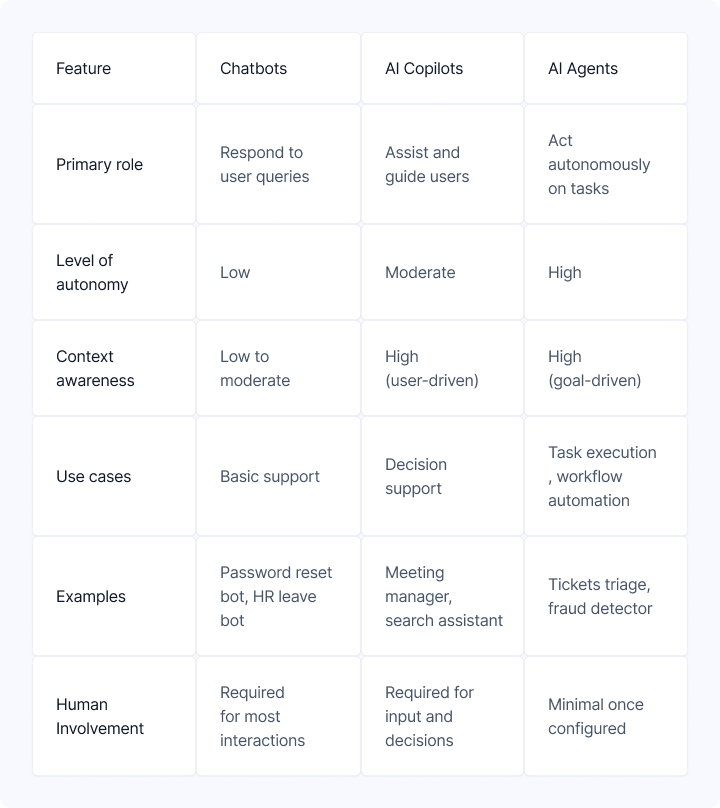
Chatbots: For simple tasks
Chatbots are the most basic form of AI assistants. They simulate conversation, usually through predefined flows or scripts, and are best suited for handling predictable, repetitive queries. For example, an HR chatbot might help employees check leave balances, update profiles, or access payslips. Meanwhile, a customer support bot might answer FAQs like “How do I reset my password?” or “Where’s my order?” While some modern chatbots use large language models for more natural responses, they typically lack deep context, autonomy, or integration with complex workflows.
AI Copilots: Insight-driven partners
AI Copilots are designed to work alongside humans, offering real-time insights, contextual guidance, and intelligent support. They don’t act on their own; they respond to user input, interpret intent, and help users make smarter decisions. For example, a Meeting Manager Copilot can summarize discussions, extract action items, and schedule follow-ups, making sure teams stay aligned and productive. In product management, AI Copilots assist in synthesizing user feedback, providing the product team with a clear roadmap for prioritizing features that directly align with customer needs.
AI Agents: Autonomous, goal-oriented executors
AI Agents go beyond assistance. They act independently. Once configured, they can execute multi-step tasks, trigger workflows, and make decisions without constant human input.
For instance:
- A Call Wrapper Agent can automatically summarize customer interactions for record-keeping, reducing after-call work for service agents.
- A Ticket Triage Agent can categorize and prioritize support tickets based on urgency and complexity, accelerating resolution.
- A Fraud Detection Agent monitors transactions in real time, flagging anomalies and triggering alerts to bolster compliance and security.
AI agents are ideal for operations, IT, finance, and support teams looking to scale efficiency and reduce manual effort.
Put simply, choosing between a chatbot, copilot, or agent isn’t just about features but more about fit.
- Need quick answers to predictable questions? → Go with a chatbot.
- Want to empower users with insights and guidance? → Deploy a copilot.
- Want to automate tasks end-to-end? → Build or adopt an agent.
Together, these tools form a layered ecosystem, one that balances human creativity with machine efficiency.
How to integrate AI Copilots into your business: a simple step-by-step guide
The potential of AI Copilots to enhance efficiency and decision-making is undeniable. But how do you take this exciting technology from concept to reality within your organization? While it may seem like a complex undertaking, integrating AI Copilots into your workflows can be straightforward with the right approach.
1. Start where it matters most
Not every corner of your business needs AI right away. Focus on areas where it can deliver the biggest impact quickly:
- Is your customer service team overwhelmed by repetitive inquiries?
- Do you have mountains of data waiting to be turned into actionable insights?
- Are project timelines slipping due to inefficiencies in workflows?
Target high-value opportunities like automating routine customer interactions, streamlining data analysis, or improving operational efficiency through tasks like ticket submission or report generation. These "quick-win" areas showcase the power of AI and build momentum for broader adoption.
2. Choose the right AI Copilot for your needs
Not all AI solutions are created equal, and buyers have a range of options to consider, from purpose-built industry solutions to versatile platforms. Selecting the right AI Copilot requires evaluating multiple factors:
- Deployment models: Are you choosing a standalone AI Copilot, an integrated solution within existing enterprise software, or a customizable AI framework?
- Integration compatibility: Does it work smoothly with your CRM, project management tools, or analytics platforms?
- Scalability: Can it scale as your business evolves and grows?
- Customization: Is it adaptable enough to meet your unique goals and challenges?
The ideal AI Copilot should not feel like just another tool but a natural extension of your operations, seamlessly enhancing productivity and driving measurable results.
3. Deploy the AI Copilot
Once you’ve chosen the right Copilot, deployment is the next critical step. Proper implementation ensures your AI solution delivers maximum value. Key steps include:
- Integration with existing systems: Configure the AI Copilot to work alongside your current tech stack, ensuring compatibility and smooth workflows.
- Configuration for business needs: Tailor the AI’s functionalities to align with specific use cases, such as customer service, sales, or operations.
- Security and compliance: Implement robust data protection measures to safeguard sensitive information. Ensure the deployment adheres to industry regulations and ethical guidelines.
- Training and testing: Involve key stakeholders early on. Conduct pilot tests to refine the system and address any gaps before full-scale implementation.
4. Get your team on board and confident
AI Copilots thrive when paired with a team that understands their potential. Your employees don’t need to become AI experts, but they do need to feel confident about working alongside this new digital teammate.
- Show the benefits: Highlight how AI simplifies tedious tasks and frees them up for more strategic, creative work.
- Offer hands-on training: Provide practical sessions on using AI tools effectively in their roles.
- Set realistic expectations: Explain what AI can and can’t do, emphasizing that it’s there to enhance, not replace human expertise.
When your team feels empowered, they’ll become champions for AI adoption across your organization.
5. Operate ethically and responsibly
Copilots must be guided by responsible AI principles to ensure their decisions and actions align with your company’s values. Ethics in AI isn’t just about doing the right thing; it’s about building trust with your employees, customers, and stakeholders.
Here’s what to focus on:
- Bias mitigation: Regularly audit your AI systems to ensure they treat all users and data fairly.
- Transparency: Make it clear how AI is making decisions, so users trust the process.
- Data security: Implement strong safeguards to protect sensitive information and comply with regulations.
6. Track progress and keep improving
AI Copilots don’t just work for you; they grow with you. Make it a habit to monitor their performance and gather feedback from your team.
- Are they meeting the goals you initially set?
- Are there new areas of your business where they could make an impact?
- What adjustments can be made to improve their efficiency or accuracy?
Regularly updating and optimizing your AI solutions ensures you’re always getting the best return on your investment. Plus, it keeps your business ahead of the curve as technology evolves.
What is the future of AI copilots?
AI Copilots are evolving from helpful assistants to strategic partners. And as they start leveraging agentic AI, they’ll soon go beyond answering questions to autonomously executing tasks, coordinating across systems, and learning from outcomes.
Here’s what’s coming:
- Proactive intelligence: Copilots will anticipate needs, flag risks, and suggest next steps, before you even ask.
- Enterprise Integration: No more silos. Copilots will connect HR, sales, ops, and IT into one seamless intelligence layer.
- Built for Scale: Security, adaptability, and performance will be non-negotiable as copilots become core to daily operations.
The organizations that embrace this shift early won’t just be more efficient. They’ll be more agile and prepared for whatever comes next.
Learn more about how AI agents and copilots can help your enterprise deliver exceptional customer and employee experience by requesting a custom demo.
FAQs
Q1. What is Copilot AI?
Copilot AI or AI Copilot is a smart assistant embedded within apps and workflows that helps users complete tasks more efficiently. It provides contextual suggestions, automates repetitive actions, and offers real-time guidance, whether you're writing an email or analysing data.
Q2. Is AI Copilot free?
Some AI Copilots offer limited free versions or trial access, especially for individual users. However, enterprise-grade features, like deep integrations, custom workflows, and advanced analytics, typically require a paid subscription or licensing agreement.
Q3. What is the difference between an AI Copilot and an AI Agent?
AI Copilots assist users by offering insights, suggestions, and support during tasks. They rely on user input and operate within a defined context. AI Agents, on the other hand, act autonomously. They can execute tasks end-to-end, make decisions, and trigger workflows without constant human involvement. Put simply, AI Copilot guides, whereas AI agents act.
Q4. Is Copilot powered by generative AI?
Yes, most modern AI Copilots use generative AI to create content, summarize information, and respond in natural language. They’re typically built on large language models (LLMs) that enable them to understand context and generate human-like output.
Q5. Which AI does Copilot use?
The underlying AI varies by provider. For example, Microsoft Copilot uses models from OpenAI and Microsoft’s own Azure AI stack. Meanwhile, platforms like Kore.ai can use any LLMs to offer tailored solutions for your business needs.

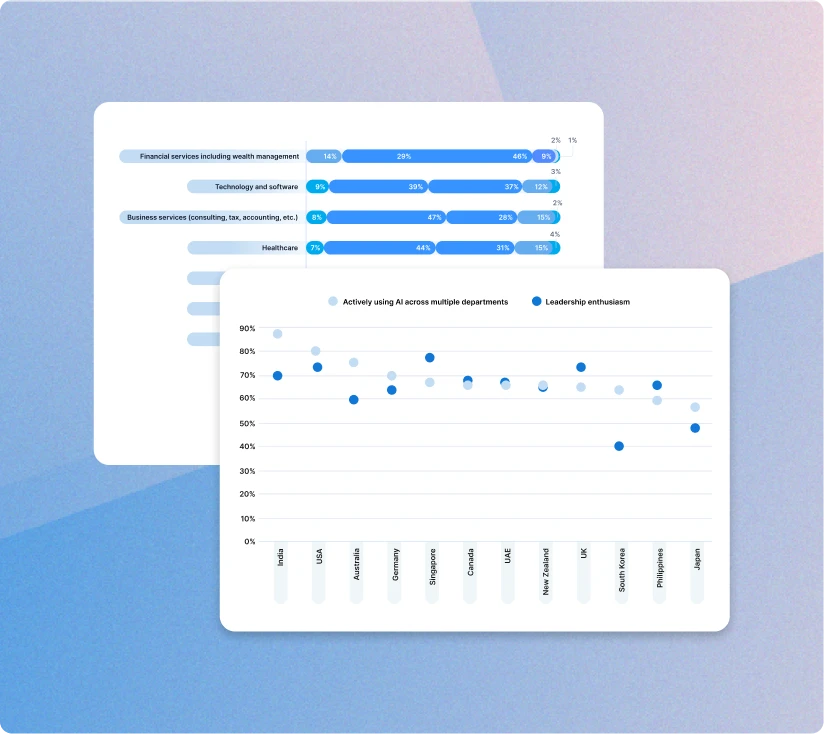


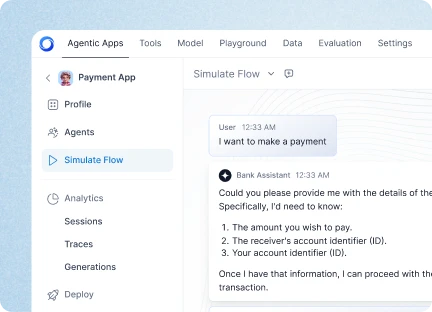


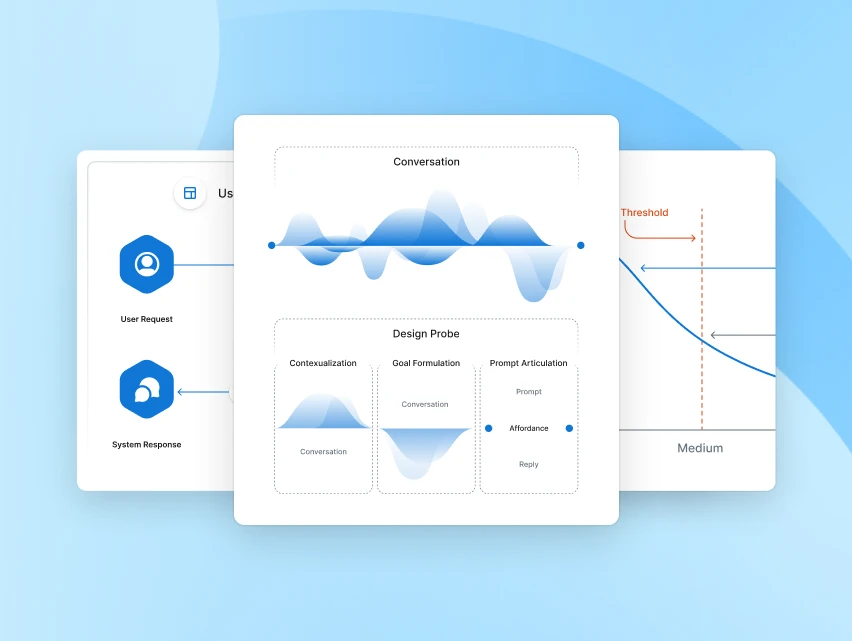
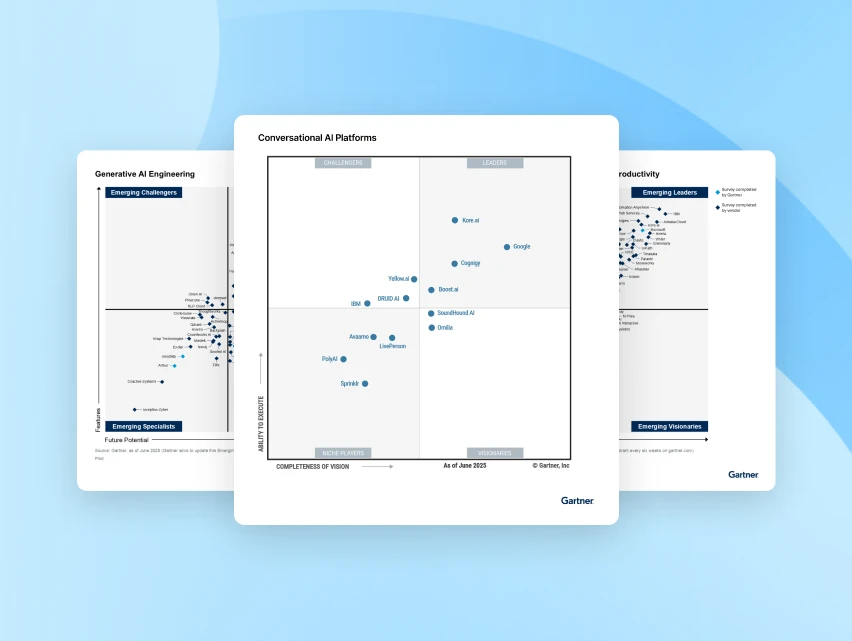
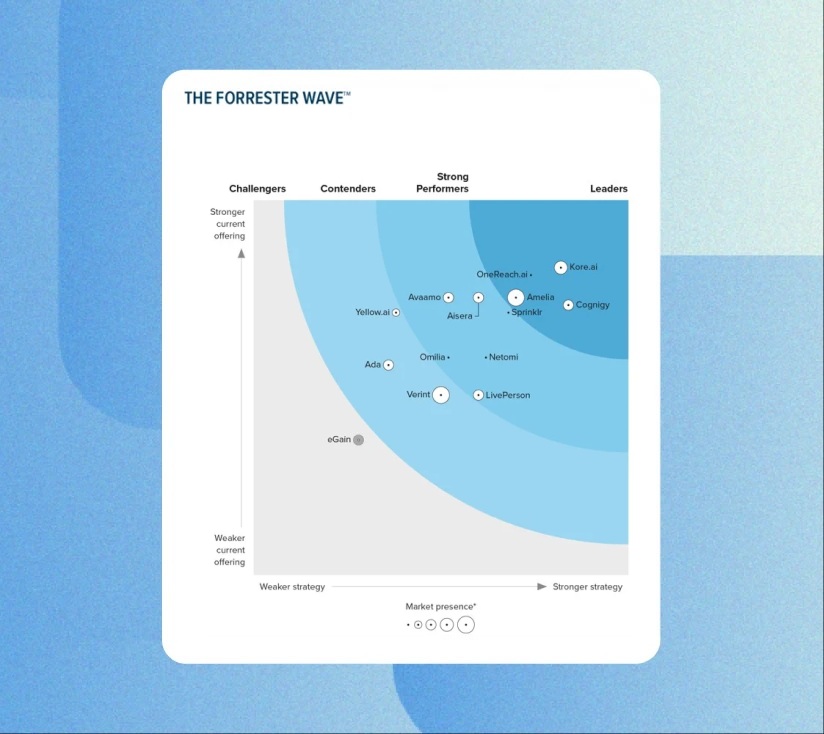


.webp)
.jpg)




